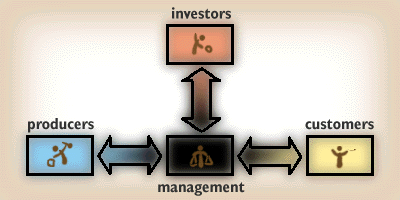
|
|
Like the other models of the MG Taylor Modeling Language, the Business of Enterprise Model is protected by copyright. You can use it only by meeting these four conditions Here's a model of the old way of doing things:
Some notes about the players in the model:
And here's how the old model works:Management's stuck in the middle, at an intersection of conflicting needs. The investor wants a higher return and a lower risk. The producer wants higher pay or fee for service for less time. The customer wants a higher quality product for less cost. Since there's no way of rationalizing these conflicting demands, management alternately focuses on one constituent at a time. For a while it was the worker: working conditions, compensation, benefits, a guarantee of a job. Products were expensive and margins slim. Then the customer was king: a lower price could be had if the suppliers were squeezed. And then getting a higher return for the investor or owner took top priority. It's as if the three constituent groups were seats on a Ferris Wheel going round and round, and whichever group happens to be at the top gets the priority And here's a model of the new way of doing things:
The same players but with slightly different roles:
And here's how the new model works: Some companies are learning how to transform a zero-sum game into an infinite game. In a zero sum game, there's a finite amount of resource and the game is to decide how it gets distributed. In an infinite game, the purpose of the game is to continue the game--to grow and expand the resource base and the distribution model. The best models to use when playing infinite games are living systems models. Ecologies of organizations, or value webs, are in the business of growing the pie and making their webs larger. But just growing an organization does not eliminate the conflict inherent in the old model. After all, many organizations experience tremendous growth rates yet only exacerbate the conflicts between their constituents. There are two more factors that must be added for the new model to be truly transformative. Take another look at the picture of the new model and the picture of the old model. You're looking for the connections between constituents. Notice that in the old model, all of the connections go through Management. In the new model, Management is the largest hub connecting the constituents, but there is a whole web of lines that connect customers, producers and investors. It's these many sub-networks that tie the players more tightly together and make them interested in their shared fortunes. These links represent true knowledge--or experientially applied information about how the different portions of the enterprise work, and about how the enterprise works together as a whole. With this knowledge in hand, each constituent can act responsibly with respect to the enterprise and serves in a small cybernetic-style management role. There's one more necessary factor that doesn't jump out at you from the model. Not only are subgroups of constituents linked together into mini nets but an individual constituent may play more than one role. An individual could be an investor, a customer and a producer all at once, and therefore have a true stake in every facet of the enterprise. To leverage that stake, the individual must also play a role in the management function--in understanding the body of knowledge that helps him or her make good decisions as a customer, investor and producer. Copyright © 1996, MG Taylor
Corporation. All rights reserved 19960827211501.web.bsc | |||||||||||||||||||||||||||||||||||||||||

















